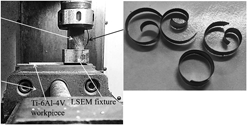Article contents
Production of fine-grained foils by large strain extrusion-machining of textured Ti–6Al–4V
Published online by Cambridge University Press: 18 December 2017
Abstract

The large strain extrusion-machining process has been used to refine the microstructure in a Titanium alloy (Ti–6Al–4V). The unconstrained cutting or machining of Ti–6Al–4V entails the formation of shear localized chips at nearly all cutting speeds, thereby hindering the use of extrusion-machining to produce fine-grained materials. The present effort attempts to suppress shear localization by the suitable modification of texture in Ti–6Al–4V through the cold-rolling process prior to extrusion-machining. Ti–6Al–4V plates were cold rolled to 30, 40, 45, and 47% thickness reductions. These textured plates were extrusion machined using a suitably designed fixture leading to fine-grained continuous foils with increased hardness. Microscopy has revealed that the suppression of shear localization in the foils produced from plates which are cold rolled to more than 40% of thickness reduction is triggered by texture formation. For thickness reductions slightly lower than 40% (e.g., 30%), suppression can be achieved only by a combination of texture and extrusion.
- Type
- Article
- Information
- Copyright
- Copyright © Materials Research Society 2017
Footnotes
Contributing Editor: Jürgen Eckert
References
REFERENCES
- 11
- Cited by





